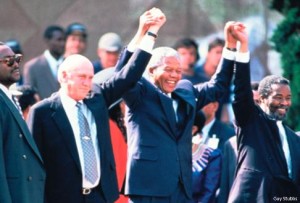 Though toward the end of our first week in Johannesburg we were a little exhausted from touring and visiting museums, the Apartheid Museum kept strong hold of my attention. The images I saw were astounding, heart-wrenching and inspiring at the same time. Combined at the Apartheid Museum was a tribute to Nelson Mandela and a walk through the history of South Africa, its journey toward democracy and its aspirations as a country. There were art exhibits, video clips of Nelson Mandela’s fight against aids, South Africa winning the world cup, and the day that Nelson Mandela was released from prison, along with remarkable stories of triumph and also of devastation. The walk through this museum was a roller-coaster of emotions and it began when you received a ticket that labeled you either Blankes or Non-Blankes (white or non-white). The moment you passed through your designated gate you were in awe.
Though toward the end of our first week in Johannesburg we were a little exhausted from touring and visiting museums, the Apartheid Museum kept strong hold of my attention. The images I saw were astounding, heart-wrenching and inspiring at the same time. Combined at the Apartheid Museum was a tribute to Nelson Mandela and a walk through the history of South Africa, its journey toward democracy and its aspirations as a country. There were art exhibits, video clips of Nelson Mandela’s fight against aids, South Africa winning the world cup, and the day that Nelson Mandela was released from prison, along with remarkable stories of triumph and also of devastation. The walk through this museum was a roller-coaster of emotions and it began when you received a ticket that labeled you either Blankes or Non-Blankes (white or non-white). The moment you passed through your designated gate you were in awe.
 Learning about life under the apartheid is hard to stomach in general, but one exhibit in particular left me numb. I turned into a room of nooses hanging from the ceiling. As you can imagine, this stunned me. I began reading about the people who were executed because of their opposition to the government—131 in total. There were personal stories about a few men and records of others. Many exhibits and stories left me just as emotional, but I turned around and there was a picture of where these men were hung and you could see how the floor was dropped from beneath them. I was truly overwhelmed.
Learning about life under the apartheid is hard to stomach in general, but one exhibit in particular left me numb. I turned into a room of nooses hanging from the ceiling. As you can imagine, this stunned me. I began reading about the people who were executed because of their opposition to the government—131 in total. There were personal stories about a few men and records of others. Many exhibits and stories left me just as emotional, but I turned around and there was a picture of where these men were hung and you could see how the floor was dropped from beneath them. I was truly overwhelmed.
Once you found a way to move past this exhibit, you were uplifted by the displays that follow. You learned about the Truth and Reconciliation Commission, led by Archbishop Desmond Tutu, which promoted forgiveness among victims and their perpetrators through disclosing truths about the apartheid. Really, it is one of the most amazing things I have ever seen established.
 Finally, there was a wall of quotations of Nelson Mandela that were written in different colors. You chose your favorite one and placed a reed of the same color along a walkway. I’ll leave you with the ones I chose:
Finally, there was a wall of quotations of Nelson Mandela that were written in different colors. You chose your favorite one and placed a reed of the same color along a walkway. I’ll leave you with the ones I chose:
“The first thing is to be honest with yourself. You can never have an impact on society if you have not changed yourself.”
“Overcoming poverty is not a gesture of charity. It is a protection of a fundamental human right, the right to dignity and a decent life.”
(You aren’t allowed to take pictures at this museum, so the ones that I have included are from the Apartheid Museum Website that you can take a look at here: http://www.apartheidmuseum.org)
Leave a Reply